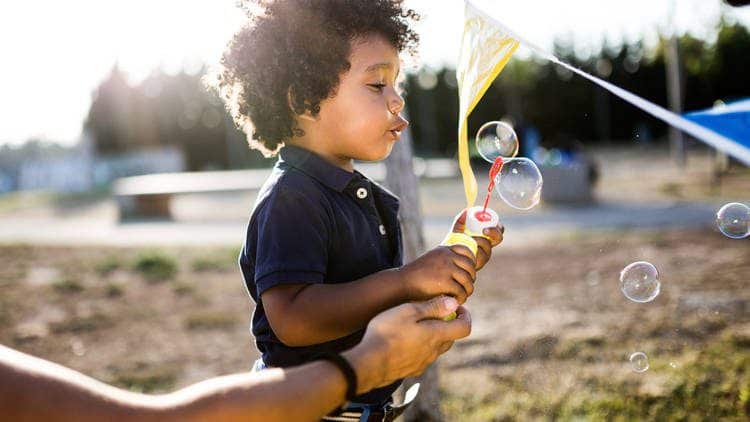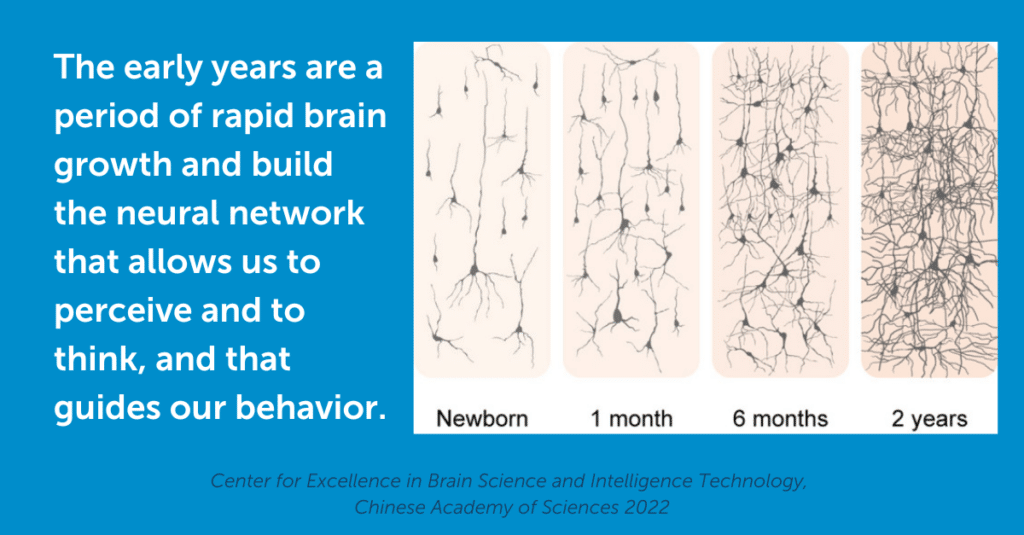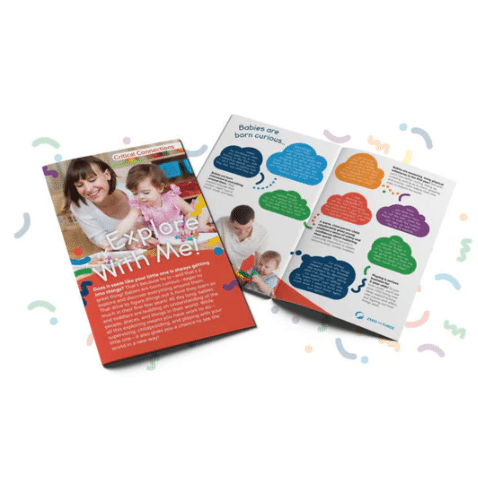Instead of the manufacturer-designed toy telling your child how to play, your child's brain has to do the heavy lifting. And that's that superfood for the brain.
Jesse Ilhardt
Buzzwords Explained: Play-Based Learning

Key Takeaways
- Humans learn fastest in early childhood — and most of that development is due to the act of play.
- When babies and toddlers get more chances to use their natural skills, they tend to stay engaged and creative learners even as they grow up.
- Training and education can help further a robust play-based model in child care centers, schools, and homes across the country.
Playful exploration is a natural way of learning. Explore how caregivers and professionals can encourage and promote play-based learning.
Featured insight from:

Katrina Macasaet
Senior PD Manager, Professional Innovations
Katrina leads our Critical Competencies and The Growing Brain professional development programs.
What is play-based learning?
Picture a bustling child care classroom, brimming with life. Some children are in one corner of the room donning costumes ranging from police officer to fairy princess, while at another table children dip leaves into paint to create unique stamps on sheets of paper. A wooden train set functions like a mirror of the big world outside — with houses, shops, vehicles, and people.
Not a single child is sitting at a desk completing a worksheet, and with strategic involvement from early childhood educators, robust learning is taking place.
Infants and toddlers learn so many things through play
- By repeating an action over and over, young children are conducting experiments. Does the marble roll the same direction off the table each time? How many blocks can they add to the tower before it falls?
- By playing with other children, infants and toddlers learn empathy, social cues, and conflict-resolution skills. Waiting in line for the slide teaches about patience, reciprocity, and even patterns — the children are waiting in a particular order for their turn.
- Through materials that mimic real life, such as play kitchens and train sets, children make observations about the way the world works, from crosswalks and stop signs to taking care of a home.
Playful exploration is a natural way of learning. When babies and toddlers get more chances to use their natural skills through play-based learning activities, they tend to stay engaged and creative learners even as they grow up. As early childhood professionals and parents, our job is to provide the tools and give them the freedom to learn at their own pace.
No fancy toys needed! Here's how to play with common household items.
Early childhood professionals should understand the value of play-based learning activities
Play is often talked about as if it were a relief from serious learning. But for children, play is serious learning. Play is really the work of childhood.
Fred Rogers
This quote from Fred Rogers sums up what many early childhood professionals already know. It also isn’t new information. We’ve long known that play-based learning is crucial to development, but it has not always been viewed as the keystone of early childhood education that it truly is. In the first three years of life, babies forge 1 million neural connections per second. Humans do not learn that fast at any other point in their lifespan — and most of that development is due to the act of play.
Furthermore, while there are numerous theories and models that suggest specific methods to facilitate play-based learning in early childhood, the key is understanding that research supports play as a central component of the learning process.

Join our next Critical Competencies for Infant-Toddler Educators training.

How to encourage play-based learning
Educate professionals. They know play is important, that’s not a question. Still, it takes training and education to embrace a robust play-based model in child care centers, schools, and homes across the country. Helping professionals make connections between play and the skills it teaches (like through our Critical Competencies training) — as well as explain the importance of it to families — strengthens the programming we are able to provide.
Provide resources. While children are wonderfully inventive and can play with any object they stumble across, it is still important to stock early childhood education programs with high-quality, safe, and diverse toys that encourage creative play-based learning. When funding and equipping spaces where infants and toddlers spend time, play materials should always be prioritized.
Change our mindset. Even though we know the importance of play, this metrics-driven world still favors structured and formulaic learning experiences that provide data points. Play can be messy, chaotic, and loud — it doesn’t always fit that mold. When we think about curriculum for really young children, most of that curriculum comes from the ways we care for them and how they play. It’s time to make that the norm.
Looking for more playtime ideas? Check out these age-based tips.

Encourage Quality Everyday Interactions
Critical Connections Parent Leaflets are a parent engagement tool for early childhood professionals.
Each engaging and easy-to-understand leaflet corresponds to a ZERO TO THREE Critical Competencies for Infant-Toddler Educators™ sub-area and is focused on everyday parent-child interactions and their positive impact on early development.

Next Up
Go to Next Resource
distillation
22 Statistics You Need to Know About Childhood Brain DevelopmentThe first three years of a child’s life are the most pivotal, and also the most vulnerable when it comes to childhood brain development.

